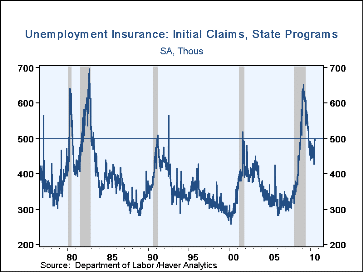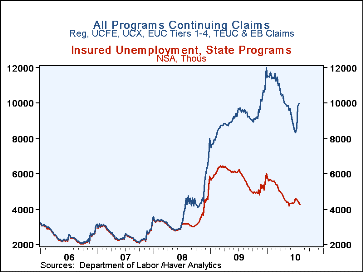 Global| Aug 19 2010
Global| Aug 19 2010U.S. Unemployment Insurance Claims Jump Back to 500,000; Total Recipients Climb Back Toward 10 Million
Summary
Unemployment insurance claims jumped unexpectedly in the week ending August 14, reaching 500,000 from an upwardly revised 488,000 the week before (originally 484,000). It was the first appearance of 500,000 initial claims since [...]
Unemployment insurance claims jumped unexpectedly in the week ending August 14, reaching 500,000 from an upwardly revised 488,000 the week before (originally 484,000). It was the first appearance of 500,000 initial claims since November 14, 2009. The 4-week moving average was 482,500 in the August 14 week, up from 474,500 August 7 and 459,250 July 31. Forecasts, according to the Action Economics consensus, called for a decrease in the weekly number to 476,000. Alas.
Continuing claims, that is, the main series of continuing claims for state-administered programs, continued to edge lower in its latest reading, covering August 7. These were 4.468 million, down from 4.491 million in the week ended July 31. The associated unemployment rate was 3.5% of covered employment, the same as the week before and down from 4.6% a year ago. This one set of claimants is, however, only about half of the total number of people currently receiving unemployment insurance. The regular extended benefits program, with eligibility dependent on conditions in individual states, has lately surged from 406,842 recipients on July 10 to 837,357 on July 31, the latest available. In July, the Congress renewed the special Emergency Unemployment Compensation program referred to as EUC 2008; by July 31, also the latest available for this program, it had 4.753 million beneficiaries. It will now accept claims through November 30 and will be continuing to pay out benefits until April 30, 2011.
Haver Analytics calculates a grand total of all claimants for unemployment insurance; this series includes these extended and emergency programs, as well as selective programs for railway employees, recently discharged veterans and federal employees. All together on July 31, the total of recipients was 9,995,650. This feels like a large number, but it is not the highest in this cycle. That was 11,988,735 in the week ended January 2, 2010. Some of this extra would have been seasonal, since these data are not seasonally adjusted.
Data on weekly unemployment insurance programs are contained in Haver's WEEKLY database and summarized monthly in USECON. Data for individual states, including the unemployment rates that determine individual state eligibility for the extended benefits programs and specific "tiers" of the emergency program, are in REGIONW, a database of weekly data for states and various regional divisions. Action Economics consensus forecasts for a collection of major economic indicators are contained in the AS1REPNA database.
| Unemployment Insurance (000s) | 08/14/10 | 08/07/10 | 07/31/10 | Yr/Yr | 2009 | 2008 | 2007 |
|---|---|---|---|---|---|---|---|
| Initial Claims | 500 | 488 | 482 | -13.0% | 572 | 419 | 321 |
| Continuing Claims | -- | 4,478 | 4,491 | -26.9% | 5,809 | 3,340 | 2,549 |
| Insured Unemployment Rate (%) | -- | 3.5 | 3.5 | 4.6 (08/08/09) |
4.4 | 2.5 | 1.9 |
| Total Continuing Claims* (NSA) | -- | -- | 9,996 | +3.7% | 9,085 | 3,884 | 2,584 |
* Calculated by Haver Analytics, as the sum of regular state programs, extended benefits, federal employees, veterans, railroad retirement board and "EUC" 2008.
Carol Stone, CBE
AuthorMore in Author Profile »Carol Stone, CBE came to Haver Analytics in 2003 following more than 35 years as a financial market economist at major Wall Street financial institutions, most especially Merrill Lynch and Nomura Securities. She has broad experience in analysis and forecasting of flow-of-funds accounts, the federal budget and Federal Reserve operations. At Nomura Securites, among other duties, she developed various indicator forecasting tools and edited a daily global publication produced in London and New York for readers in Tokyo. At Haver Analytics, Carol is a member of the Research Department, aiding database managers with research and documentation efforts, as well as posting commentary on select economic reports. In addition, she conducts Ways-of-the-World, a blog on economic issues for an Episcopal-Church-affiliated website, The Geranium Farm. During her career, Carol served as an officer of the Money Marketeers and the Downtown Economists Club. She has a PhD from NYU's Stern School of Business. She lives in Brooklyn, New York, and has a weekend home on Long Island.







